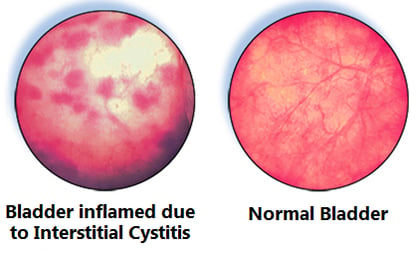For complicated cases of Interstitial Cystitis, urodynamics testing may be recommended. What is urodynamics and interstitial cystitis? How are urodynamics tests performed, and for whom are they recommended? The answers to these questions will be discussed here.
What is Interstitial Cystitis?
Interstitial Cystitis (IC) is also known as Painful Bladder Syndrome, Bladder Pain Syndrome, or Chronic Pelvic Pain. This painful condition causes bladder pressure, bladder pain, and pelvic pain. There are two sub-types of IC, ulcerative and non-ulcerative.

A non-ulcerative patient (which makes up 90% of cases) has pinpoint hemorrhages on the bladder wall, while an ulcerative patient (5 – 10% of cases) has Hunner’s ulcers on the bladder wall. Because there are many forms of IC, and patients respond differently to treatment, the National Institute of Diabetes and Digestive and Kidney Diseases is currently working on a multidisciplinary approach to the study of chronic pelvic pain to better understand this disease.
What are the Symptoms of Interstitial Cystitis?
The symptoms of IC include:
- Chronic pelvic pain
- Pain between vagina and anus (in women)
- Pain between scrotum and anus (in men)
- Frequent, urgent need to urinate
- Frequent urination (up to 20 times per day)
- Discomfort when bladder is full
- Relief after urination
- Painful intercourse
How is Interstitial Cystitis Diagnosed?
IC can be misdiagnosed as numerous disorders, such as a urinary tract infection or chronic prostatitis for men. To rule out other causes for bladder pain and frequent urination, the following diagnostic tools may be used:
- Bladder diary
- Pelvic exam
- Cytoscopy
- Biopsy
- Urine cytology
- Potassium test
- Urodynamics1
Urodynamics and Interstitial Cystitis: What Tests are Performed?
Urodynamics is typically reserved for complicated cases of IC that are difficult to diagnose. Urodynamics refers to a group of tests which help determine how well your lower urinary tract functions. In addition, doctors will receive data on the volume of urine that your bladder can hold, the volume of urine contained in the bladder before the urge to urinate is felt, how the bladder muscle functions, if there is a pelvic floor dysfunction, and whether urine is retained in the bladder after voiding.
During a urodynamics2 and interstitial cystitis exam, a small catheter is inserted into the bladder. After the bladder is emptied, the bladder may be refilled in order to take measurements such as:
- Post-void residual volume: this test determines how well the bladder empties, and the volume of urine that remains in the bladder after urination.
- Uroflowometry: how quickly the bladder is emptied is tested here. In addition to the rate of urination, bladder and rectal pressure is measured. This test can determine if bladder muscle weakness or an obstruction is to blame for IC symptoms.
- Multichannel cystometry: this test measures pressure in the rectum and bladder and uses two pressure catheters. The presence of contractions in the bladder wall during bladder filling is determined, and the strength of the urethra is also examined.
- Urethral pressure profilometry: the strength of sphincter contraction is examined with this test.
- Electromyography: electrical activity in the bladder neck is measured to test the strength of the urethral walls.
- Fluoroscopy: a video x-ray will help doctors observe the bladder and bladder neck during urination to identify weaknesses.
What Should a Patient Expect during Urodynamics Testing?
Urodynamics and Interstitial Cystitis can be scary, but researchers have found urodynamics to be useful for diagnosing3 irritative voiding conditions. These tests are not painful, but patients may experience feelings of pressure or discomfort. Make sure to ask your doctor for special instructions, as you may be required to arrive with a full bladder.
You may experience an IC flare after testing, so it is important to have a plan in place should this situation occur. Also plan to have a friend or family member drive you home after testing is complete. Overall, urodynamics testing should take approximately 30 minutes to complete.
If you found the above interesting you might also be interested in this Blog Post regarding Urodynamics Best Practices.
References
- Kuo, Y., & Kuo, H. (2013). The role of urodynamic study in evaluation of interstitial cystitis/painful bladder syndrome. Tzu Chi Medical Journal, 25(3), 131-134. doi:10.1016/j.tcmj.2013.01.010
- Kuo, Y., & Kuo, H. (2013). The urodynamic characteristics and prognostic factors of patients with interstitial cystitis/bladder pain syndrome. International Journal of Clinical Practice, 67(9), 863-869. doi:10.1111/ijcp.12116
- Sastry, D. N., Hunter, K. M., & Whitmore, K. E. (2009).Urodynamic testing and interstitial cystitis/painful bladder syndrome. International Urogynecology Journal, 21(2), 157-161. doi:10.1007/s00192-009-1015-6


